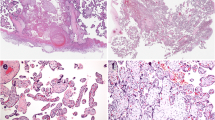Summary
Placentae from pregnancies complicated by Rhesus-incompatibility regularly show a severe arrest of maturation. 14 placentae from pregnancies with manifest Rhesus-incompatibility are morphometrically studied and compared with 10 normal placentae. While both groups show a trophoblast surface of similar size, the syncytiocapillary, respectively—sinusoidal metabolic exchange surface in Rhesus-placentae is about 2/3 smaller than in normal, mature placentae. The intravillous vascularisation is about 3/4 lower. The functional importance for the placental exchange processes is explained. By correlating the morphometrical results to the newborns' fate, it is concluded that the absolute placental insufficiency—always combined with perinatal death—must be assumed in the following approximate range: Surface of membranes for metabolic exchange below 3.6 sqm, intravillous blood-volume below 45 ml and intravillous vascularisation—grade below 0.1. The validity of these figures is assumed also for disturbances of placental maturation for other reasons.
Zusammenfassung
Placenten von Schwangerschaften, die durch eine Rhesus-Inkompatibilität kompliziert sind, weisen regelmäßig einen schweren villösen Reifungs-Arrest auf. 14 Placenten von Schwangerschaften mit einer manifesten Rhesus-Inkompatibilität werden im Vergleich mit 10 „normalen“ Placenten morphometrisch untersucht. Während beide Kollektive eine ähnliche Größe der Trophoblast-Oberfläche aufweisen, ist die synzytio-kapilläre bzw. -sinusoidale Austauschfläche bei Rhesus-Placenten um fast zwei Drittel kleiner als in normal ausgereiften Placenten, die intravillöse Vascularisation ist um ca. drei Viertel geringer. Die funktionelle Bedeutung für die placentaren Austausch-Vorgänge wird erläutert. Durch die Korrelation der morphometrischen Ergebnisse mit dem Kinds-Schicksal wird gefolgert, daß die absolute Placenta-Insuffizienz, die mit perinatalem Fruchttod vergesellschaftet ist, in folgender Größenordnung anzunehmen ist: Oberfläche der Stoffwechsel-Membranen unter 3,6 m2, intravillöses Blutvolumen unter 45 ml, intravillöser Vascularisations-Grad geringer als 0,1. Die Gültigkeit dieser Werte wird für placentare Ausreifungsstörungen auch aus anderer Ursache angenommen.
Similar content being viewed by others
Literatur
Aherne, W., Dunnill, M. S.: Morphometry of the human placenta. Brit. med. Bull.22, 5 (1966)
Aherne, W., Dunnill, M. S.: Quantitative aspects of placental structure. J. Path. Bact.91, 123 (1966)
Bartels, H., Moll, W.: Passage of inert substances and oxygen in the human placenta. Pflügers Arch. ges. Physiol.280, 165 (1964)
Becker, V.: Funktionelle Morphologie der Placenta. Arch. Gynäk.198, 3 (1962)
Becker, V.: Die Chronopathologie der Placenta. Dtsch. med. Wschr.96, 1845 (1971)
Becker, V., Bleyl, U.: Placentazotte bei Schwangerschaftstoxikose und fetaler Erythroblastose im fluoreszenzmikroskopischen Bild. Virchows Arch. path. Anat.334, 516 (1961)
Bender, H. G., Brandt, G.: Morphologie und Morphometrie der Fünflings-Placenta. Arch. Gynäk.216, 61 (1974)
Busch, W., Vogel, M.: Die Placenta beim „Morbus haemolyticus neonatorum“. Z. Geburtsh. Gynäk.176, 17 (1972)
Botella-Llusia, J.: La physiologie du placenta. Gynéc. et Obstét.48, 346 (1949)
Christoffersen, A. K.: La superficie des villosités choriales du placenta à la fin de la grossesse (étude d'histologie quantitative). C. R. Soc. Biol. (Paris)117, 641 (1934)
Clavero-Nunez, J. A., Botella-Llusia, J.: Measurement of the villus surface in normal and pathologic placentas. Amer. J. Obstet. Gynec.86, 234 (1963)
Dawes, G. S., Mott, J. C., Widdicombe, J. G.: The foetal circulation in the lamb. J. Physiol. (Lond.)126, 563 (1954)
Dees-Mattingly, M.: Absorptive area and volume of chorionic villi in circumvallatae placentas. Amer. J. Anat.59, 485 (1936)
Dodds, G. S.: The area of the chorionic villi in the full term placenta. Anat. Rec.24, 287 (1922)
Ehrhardt, G., Gerl, D.: Eine einfache Methode zur Bestimmung der Zottenoberfläche von Placenten mit Hilfeder Flächenintegration nach der „Nadelmethode.“ Zbl. Gynäk.92, 728 (1970)
Geissler, U., Holtorff, J., Hempel, K.: Morphometrische Studien an der Placenta. Teil I: Die Größe der Zottenoberfläche am Ende der normal verlaufenden Schwangerschaft. Zbl. Gynäk.94, 4 (1972)
Geissler, U., Holtorff, J.: Morphometrische Studien an der Placenta. Teil II: Größe der Resorptionszottenoberfläche nach Risikoschwangerschaften. Zbl. Gynäk.94, 888 (1972)
Hennig, A.: Kritische Betrachtungen zur Volumen- und Oberflächenmessung in der Mikroskopie. Zeiss Werkschrift30, 78 (1958)
Janisch, H., Leodolter, S.: Ergebnisse der Placentadurchströmungsmessung bei Risikoschwangerschaften. Z. Geburtsh. Gynäk.177, 74 (1973)
Knopp, J.: Das Wachstum der Chorionzotten vom II. bis X. Monat. Z. Anat. Entwickl.-Gesch.122, 42 (1960)
Neuer, H.: Mengenanalyse mit dem Mikroskop. Zeiss Werkschrift60, 65 (1966)
Rech, W.: Untersuchungen über die Größe der Zottenoberfläche der menschlichen Placenta. Z. Biol.80, 329 (1924)
Werner, Ch., Bender, H. G., Klünsch, H.: Morphologische Placentabefunde in Abhängigkeit vom Schweregrad der EPH-Gestose. Geburtsh. u. Frauenheilk. (im Druck)
Werner, Ch., Schneiderhan, W.: Placentamorphologie und Placentafunktion in Abhängigkeit von der diabetischen Stoffwechselführung. Geburtsh. u. Frauenheilk.32, 891 (1972)
Wilkin, P.: Etude des facteures physiques conditionnent la permeabilité placentaire. Bull. Féd. Soc. Gynéc. Obstét. franç.9, 33 (1957)
Wilkin, P., Bursztejn, M.: Etude quantirative de l'évolution de la surface d'échange placentaire au cours de la grossesse. Bull. Féd. Soc. Gynéc. Obstét. Franç.9, 37 (1957)
Wilkin, P., Bursztejn, M.: Etude quantitative de l'évolution au cours de la membrane d'échange du placenta humain. In: Snoeck, Le placenta humain. Paris: Masson et Cie. 1958
Wislocki, G. B., Dempsey, F. W.: Electron microscopy of the human placenta. Anat. Rec.123, 133 (1955)
Author information
Authors and Affiliations
Additional information
Mit dankenswerter Unterstützung durch die Deutsche Forschungs-Gemeinschaft.
Rights and permissions
About this article
Cite this article
Bender, H.G. Placenta-Insuffizienz. Arch. Gynak. 216, 289–300 (1974). https://doi.org/10.1007/BF00668625
Received:
Issue Date:
DOI: https://doi.org/10.1007/BF00668625




